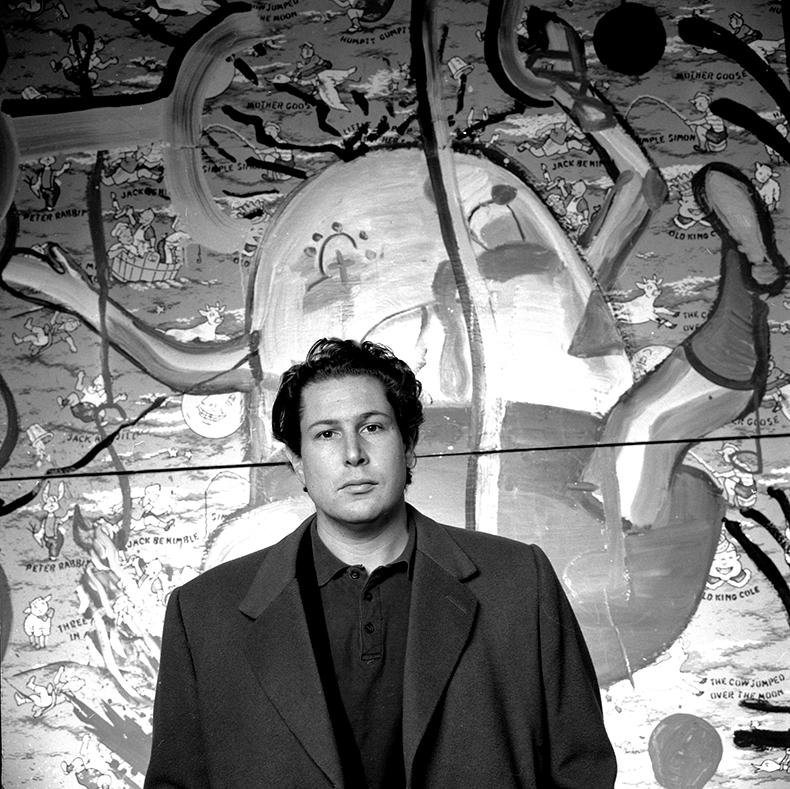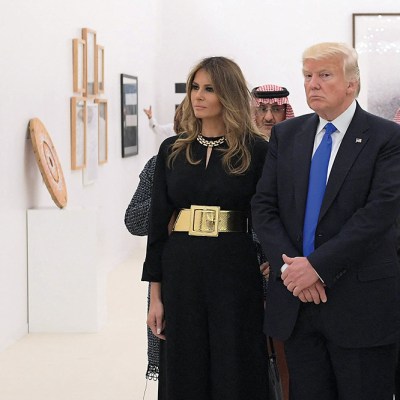From the October 2024 issue of Apollo. Preview and subscribe here.
Eastcastle Street in the West End of London has been the home of a number of innovative galleries since Stuart Shave and Pilar Corrias set up there more than a decade ago. This summer it was the location for a ‘micro-fair’ showing work made by 19 recent graduates and priced at under £600 – a stark contrast to the £10,000 for young artists commonly seen at fairs such as Frieze. Over a long weekend in July, young people waited to enter in two-hour time slots, thanks to the small space and the strictures of Westminster City Council.
The (Actually) Attainable Art Fair (a sly reference to the price levels at the Affordable Art Fair franchise) was the idea of ST.ART Gallery founder Charlie Pannell. After graduating from Central Saint Martins in 2021, Pannell wanted to find ways to give his peers exposure in the long gap between art school and securing representation by the kind of gallery that can afford international fairs and charge collectors accordingly.
The enthusiasm of visitors made Pannell realise that there are many people in their twenties and thirties who could spend a few hundred pounds on art but have never done so before. ‘There’s such exclusivity in the art world – the old adage that if you have to ask the price you can’t afford it,’ he says. ‘There was this beautiful moment, when young people saw something and went: “Wow! That’s something I love and I can bring it home with me”.’
Pannell will hold a second edition of the fair in November. But it’s not just emerging gallerists who are thinking about ways to attract new buyers this autumn – so are major auction houses, galleries and fairs. ‘There’s a real concern that younger collectors aren’t coming up and that the art market is stagnating,’ says Jacob King, founder of New York blue-chip art advisory Fine Art Concepts. ‘There seems to be a disconnect between the young people looking at art I see around Tribeca and Chelsea each weekend and what is happening in the market.’
Of course, galleries and auction houses have always been on the lookout for clients. In 1981 the New York market was driven by a cadre of ‘hot’ young artists and dealers, including two 30-year-olds, Julian Schnabel and his gallerist Mary Boone. They were credited for attracting high-spending young buyers into what had been a staid market of mature collectors.
The American artist and film-maker Julian Schnabel in 1984. Schnabel, and his gallerist Mary Boone, helped spawn a younger and more diverse cadre of collectors in 1980s New York. Photo: Jack Mitchell/Getty Images

At the time, Arne Glimcher, the 43-year-old founder of Pace Gallery, proudly told the New York Times that ‘more than half of our clients are under 50’. The late Norman Hirschl boasted he had buyers in their early forties and ‘even thirties’, from ‘the entertainment business, motion pictures and recording, as well as Wall Street bankers’.
This was the first real flowering of a contemporary art market, though many of these new buyers would melt away when the 1980s bubble burst in the crash of 1991.
Today’s sense of urgency is driven partly by the fact that the art market is falling for the second year in a row. Combined sales at Sotheby’s, Christie’s and Phillips fell by 27 per cent in the first half of this year, after a 19 per cent reduction in 2023. A survey of 128 art market insiders by analysts ArtTactic found that only 6 per cent thought the market would improve over the next six months and nearly a third thought it would get worse.
More worrying, the value of the global art market has remained around $65bn for more than a decade, a serious fall in real terms. This contrasts with the predictions that the ranks of the young and wealthy are set to grow, while reports indicate that the number of high-networth individuals increased by 5 per cent last year. Why the rise in wealth is not translating into art sales is the subject of some debate.
Eugenio Re Rebaudengo is the 36-year-old scion of a famous family of art collectors – his mother Patrizia has a foundation in Turin and will soon open a second on an island in Venice. In 2013 he launched Artuner, which produces boutique selling exhibitions of younger artists. ‘I’ve been in the art world for 15 years and until recently I was always the youngest at gallery and museum [collector] dinners,’ he says. ‘Now that’s beginning to change, but there’s still not as many people of my age as I would like or hope for.’
He thinks one of the difficulties for potential young collectors is the quantity and range of art on show. ‘We have too much material to get a sense of what’s going on – there’s so much it is hard to know what is important and what to focus on,’ he says. ‘Access to information is great but it does present challenges.’
Magnus Resch, a lecturer on art management at Yale and the author of a recent book, How to Collect Art, says ‘I don’t believe we’ve seen a significant cohort of younger buyers emerge just yet.’ He thinks the structure of the art market is at fault: ‘Young buyers are uncertain about the return on art investments and overwhelmed by the volume of available options.’
Meanwhile, after some progress during the pandemic, galleries have largely rowed back on online selling and openness about prices. ‘The lack of transparency remains a major hurdle,’ Resch says. ‘Many people are put off by the idea that they have to enquire, negotiate and potentially overpay.’
Another theory is that there are new buyers, but they are buying at lower prices and not in enough quantity to make up for the current decline in multi-million-dollar sales. Data gathered by ArtTactic would appear to back this up. Sales of work priced under $50,000 are booming at the auction houses: totals for young contemporary artists at this level have almost doubled since 2022.
Freddie Powell runs Ginny on Frederick, one of the most exciting emerging galleries in London. It has been selected for fairs such as Liste in Basel, Independent in New York and, this month, London’s Frieze. Prices are relatively modest – from £4,000 to £25,000, with the majority under £12,500.
He says his gallery is doing well. ‘We are attracting young collectors from the creative industries, and from finance and tech, but you don’t come to us for an investment buy, we aren’t that sort of gallery,’ Powell says. ‘People come because they want to get in early on an artist’s career. Buying artists from your own generation makes sense – you probably share a lot of interests and align with their cultural references.’
Installation view of Deborah-Joyce Holman’s installation Moment 2 at Ginny on Frederick’s booth at the Independent art fair, New York, in 2024

The auction house Phillips, meanwhile, focuses mostly on the upper-middle market: prices between $500,000 and $5m. It has had a reputation for appealing to younger collectors since the early 2000s, when it was owned by Simon de Pury. He pioneered lifestyle collecting – finding new buyers by promoting luxury goods like watches alongside art and design.
Cheyenne Westphal, Phillips’ global chair, believes de Pury was ahead of his time and confirms the strategy is paying off today. She says that in the first half of the year a quarter of buyers and bidders at Phillips were Millennials or Gen Z (so aged 44 or under).
Young collectors, she says, share their enthusiasms on WhatsApp and WeChat and the opinions of curators and experts are valued less than those of their peers. ‘They know what the artist has been selling for at galleries, how hard it is to get their work and what it is being traded for afterwards. They have a clear idea of what they think something is worth. Our staff have to work hard to be part of that conversation.’
But there may be bigger forces at work than all these factors. The art market as we know it now is the result of a short period of unprecedented growth, more than trebling in value from the mid 1990s until the early 2010s. This was driven by globalisation and a new fascination with modern and contemporary art among collectors who are well known today.
These include ‘trophy’ buyers such as the hedge fund manager Steve Cohen and the late Microsoft co-founder Paul Allen – both with more than a whiff of Charles Foster Kane about them. Then there are the modern-day Medicis: the likes of Maja Hoffmann, François Pinault and Don and Mera Rubell, who have not only shaped the market but have also, through their patronage and donations, elevated artists and influenced museum acquisitions.
‘There’s a generational shift in collecting going on, with a changing of the guard who defined the past 30 years,’ says Noah Horowitz, chief executive of Art Basel. The new generation are mostly self-made people who come from all over the world. ‘Buying art is no longer the preserve of the European and American upper-class,’ he says. ‘But new collectors also have more in common with other young people in cities like Berlin, Los Angeles and Mexico City than their forebears in their own locations.’
They also have little loyalty to individual artists or galleries. ‘Earlier generations built collections hand-in-hand with dealers in a linear, focused way,’ Horowitz says. ‘The new generation is much more diversified and their tastes are widespread. In one way it is exciting, but it is also keeping us all on our toes.’
A new younger generation of collectors may raise even bigger questions for the art market. Much has been written about the fact that Millennials value ‘experiences’ more than ‘things’. As they age and their wealth grows, will they have the same desire to buy large collections, overspilling from their homes into warehouses and private museums as their predecessors did?
And will they want to back artists’ careers when there are so many to choose from and when ideas of what is great art have never been so disputed? A big art fair might have work by more than 4,000 artists on show, including ‘rediscovered’ work by women and marginalised communities or from previously disregarded territories, Indigenous art, outsider art and work by rising artists from a huge range of cultures. There is a bewildering array of offerings and little critical consensus about what will be of long-term value.
The pessimistic view is that this could have a serious knock-on effect for institutions. If younger people’s tastes are more diverse – embracing fashion, street art, music and luxury as much as fine art – they may be less eager to support biennials, museums and scholarship than collectors have been since the 19th century. And that would have an effect well beyond the art market.
From the October 2024 issue of Apollo. Preview and subscribe here.



